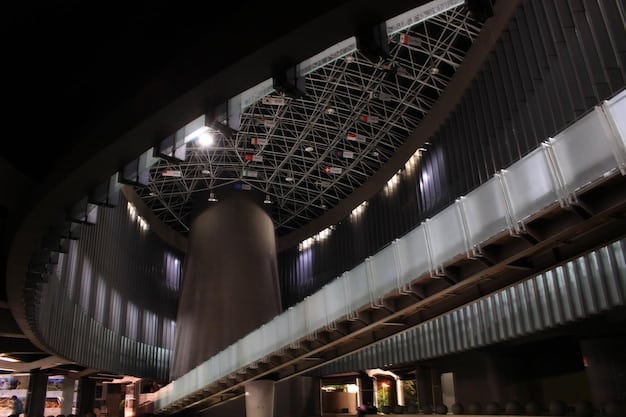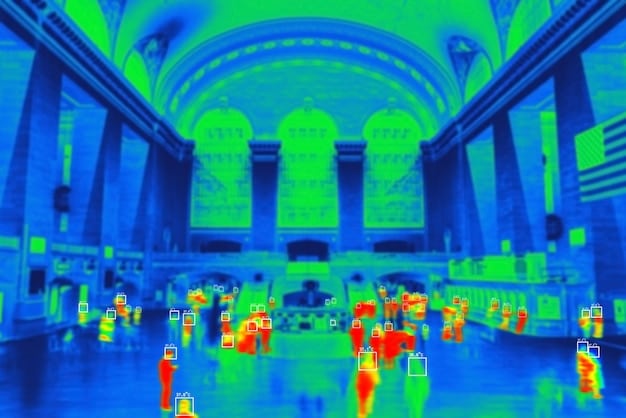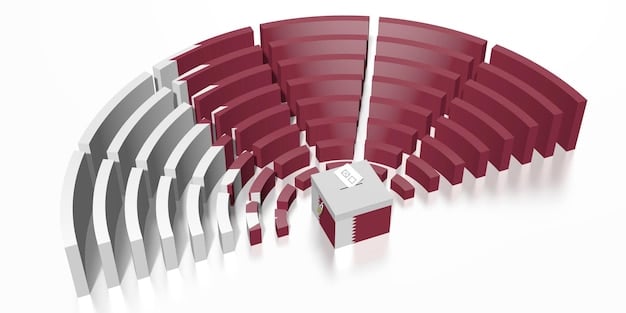Decoding Stage Security: 5 Safety Protocols for 2025 Concerts

Decoding Stage Security reveals the essential safety protocols evolving for concerts by 2025, emphasizing enhanced measures in crowd management, cybersecurity, structural integrity, emergency response, and technological integration to ensure attendee and performer safety.
Concert experiences thrive on energy and excitement, but behind the scenes, decoding stage security is paramount to ensuring the safety of everyone attending. In 2025, expect to see many new changes in concert stage security as venues try to deliver great experiences in a safe way.
Decoding Stage Security: 5 Updated Safety Protocols for Concerts in 2025
The landscape of live music events is constantly evolving, and with it, the protocols that keep performers and audiences safe. As we look ahead to 2025, it’s clear that advancements in technology, combined with lessons learned from past incidents, are shaping a new era of concert security. From enhanced crowd management techniques to cutting-edge cybersecurity measures, the goal is to create an environment where everyone can enjoy the music without compromising safety.
This article dives into five crucial safety protocols that are set to redefine stage security at concerts in 2025. These aren’t just minor tweaks; they represent a fundamental shift in how venues approach security, integrating proactive strategies and innovative tools to mitigate risks. Whether you’re a concert-goer, a performer, or an event organizer, understanding these protocols is essential for navigating the future of live music.
Crowd Management Reinvented
Effective crowd management is the cornerstone of concert safety. It’s more than just directing people; it’s about understanding crowd dynamics and proactively preventing situations that could lead to injury or panic. By 2025, crowd management will be transformed by technology and data-driven insights.
Advanced technologies are leading the way with data and tools to help make crowd management more effective:
Predictive Analytics
Predictive analytics utilize historical data and real-time information to forecast crowd behavior. By analyzing patterns from previous events, security personnel can anticipate potential hotspots and bottlenecks, allowing them to deploy resources strategically.
AI-Powered Surveillance
Artificial intelligence enhances surveillance capabilities by automatically detecting unusual behavior or crowd density. AI algorithms can flag potential security threats, such as unauthorized access or the formation of dangerous crowd surges, enabling rapid response from security teams.

- Real-Time Monitoring: Utilizing drones and CCTV cameras equipped with advanced sensors to provide continuous oversight of crowd movement.
- Communication Systems: Implementing secure communication channels for security personnel to coordinate effectively during emergencies.
- Trained Staff: Enhancing training programs for security staff to better manage crowds and respond to incidents.
These technological advancements are complemented by enhanced training programs for security staff. They learn to identify subtle signs of distress, de-escalate potentially volatile situations, and coordinate effectively during emergencies. The focus is on creating a proactive security team that can anticipate and respond to issues before they escalate.
The reinvention of crowd management in 2025 prioritizes the use of predictive technologies and staff training to create a safer, more enjoyable concert experience for all attendees.
Cybersecurity Takes Center Stage
In an increasingly digital world, concert venues are vulnerable to cyberattacks. From ticketing systems to stage equipment, nearly every aspect of a modern concert relies on digital infrastructure. Protecting this infrastructure from cyber threats is critical for maintaining security and ensuring the event runs smoothly.
As the threat of cybercrime grows, so do the steps that are taken to ensure the safety of all involved and the protection of sensitive data:
Protecting Sensitive Data
Venues must implement robust cybersecurity measures to protect customer data, including ticket information, financial details, and personal information. Data breaches can lead to identity theft and financial fraud, eroding trust and damaging the reputation of the venue.
Securing Stage Equipment
Stage technology, including lighting, sound systems, and video displays, is often controlled digitally. Hackers could potentially disrupt these systems, causing chaos or even endangering performers. Securing stage equipment is essential for ensuring a safe and seamless performance.
- Advanced Encryption: Implementing end-to-end encryption for all data transmissions to prevent interception.
- Regular Audits: Conducting frequent cybersecurity audits to identify and address vulnerabilities in the venue’s digital infrastructure.
- Incident Response Plans: Developing comprehensive incident response plans to quickly address and contain any cybersecurity breaches.
Furthermore, venues are investing in advanced threat detection systems that can identify and neutralize cyberattacks in real-time. These systems use machine learning to adapt to emerging threats and provide continuous protection against a wide range of cyber risks.
With cybersecurity taking center stage, concert venues are safeguarding not only their digital assets but also the safety and trust of their audience.
Structural Integrity and Safety
The physical structure of a concert venue, including the stage, rigging, and support systems, must be able to withstand the demands of a live performance. Ensuring structural integrity is vital for preventing accidents and protecting performers and attendees from harm.
Constant monitoring and testing should be done to ensure structural integrity:
Regular Inspections
Venues should conduct regular inspections of all structural components to identify signs of wear, damage, or corrosion. These inspections should be carried out by qualified engineers and technicians who can assess the safety of the structure.
Load Testing
Load testing involves subjecting the stage and support systems to simulated loads to ensure they can handle the weight and forces of a live performance. Load testing can reveal weaknesses in the structure before they lead to failures.

- Material Science Advancements: Utilizing stronger, lighter materials in stage construction to enhance load-bearing capacity and reduce the risk of structural failure.
- Sensor Integration: Integrating sensors into the stage structure to continuously monitor stress levels and detect potential issues in real-time.
- Safety Standards: Adhering to rigorous safety standards and regulations to ensure all structural components meet or exceed industry benchmarks.
Additionally, venues are incorporating advanced monitoring systems that can detect subtle changes in the structure. These systems use sensors to measure stress, vibration, and temperature, providing early warnings of potential problems. This allows for timely maintenance and repairs, preventing major structural failures.
By prioritizing structural integrity and safety, concert venues create a secure environment for performers and attendees.
Enhanced Emergency Response Systems
Despite the best preventive measures, emergencies can still occur at concerts. Whether it’s a medical incident, a security threat, or a natural disaster, having a robust emergency response system is crucial for minimizing harm and ensuring the safety of everyone involved.
When the unexpected happens, venues must provide quick, thoughtful, and effective ways to handle the emergency:
Comprehensive Planning
Venues should develop comprehensive emergency response plans that address a wide range of potential scenarios. These plans should include evacuation procedures, medical protocols, and security measures.
Trained Personnel
Emergency response teams should consist of trained medical personnel, security staff, and venue employees who can quickly respond to emergencies. Regular drills and training exercises can ensure that they are prepared to act effectively under pressure.
- Advanced Communication Networks: Establishing secure communication networks that enable real-time information sharing among emergency responders.
- Automated Alert Systems: Implementing automated alert systems that can quickly notify attendees of potential threats and provide instructions.
- Designated Safe Zones: Creating designated safe zones within the venue where attendees can seek shelter during emergencies.
In addition, venues are incorporating advanced technologies such as mobile apps that provide real-time updates and instructions to attendees during emergencies. These apps can also be used to report incidents and request assistance, improving the overall effectiveness of the emergency response.
With enhanced emergency response systems, concert venues are prepared to handle any crisis to protect the safety of their audience and staff.
Technological Integration for Overall Safety
Technology plays a central role in modern concert security, integrating various systems and tools to enhance overall safety. From facial recognition to drone surveillance, technology provides the tools needed to protect performers, guests, and employees at concert venues.
Many new concert venues are being designed with technology in mind to improve safety in ways that were not previously possible:
Facial Recognition Technology
Facial recognition technology can identify individuals with known security risks, such as banned patrons or potential threats. This technology enhances security by preventing unauthorized access and allowing security personnel to quickly respond to potential incidents.
Drone Surveillance
Drones equipped with cameras and sensors can provide aerial surveillance of the venue, allowing security personnel to monitor crowd movement, detect potential security threats, and respond to incidents in real-time.
- Integrated Security Platforms: Implementing integrated security platforms that combine various technologies into a unified system for enhanced situational awareness.
- Data Analytics: Utilizing data analytics to identify patterns and trends that can inform security strategies and improve overall safety.
- Biometric Scanning: Employing biometric scanning technologies for secure access control and identity verification.
Moreover, venues are exploring the use of virtual reality simulations for training security personnel. These simulations allow them to practice responding to various scenarios in a safe and controlled environment, improving their readiness and effectiveness.
By integrating technology into every aspect of security, concert venues are creating safer, more secure environments for everyone.
| Key Point | Brief Description |
|---|---|
| 🚨 Crowd Management | Predictive analytics and AI surveillance enhance safety. |
| 🔒 Cybersecurity | Protecting data and stage equipment from cyber threats. |
| 🏗️ Structural Safety | Regular inspections and load testing for venue integrity. |
| 🚑 Emergency Response | Comprehensive plans & trained personnel for quick action. |
FAQ
▼
AI enhances security by detecting unusual behavior, managing crowd density, and identifying potential threats in real-time through advanced surveillance systems and predictive analytics, enabling faster responses.
▼
Venues use advanced encryption, conduct regular cybersecurity audits, implement incident response plans, and employ advanced threat detection systems to protect sensitive data and secure stage equipment from cyberattacks.
▼
Venues conduct regular inspections by qualified engineers, perform load testing to simulate performance conditions, use stronger materials in construction, and integrate sensors to monitor stress levels continuously.
▼
Emergency response systems include comprehensive planning, trained personnel, advanced communication networks, automated alert systems, and designated safe zones to effectively manage and respond to various emergency scenarios.
▼
Technology integrates facial recognition, drone surveillance, biometric scanning, and data analytics into security platforms to enhance situational awareness, control access, and identify potential security risks in real time.
Conclusion
As we move closer to 2025, the evolution of stage security at concerts reflects a commitment to leveraging technology and data-driven strategies to protect both performers and attendees. By focusing on crowd management, cybersecurity, structural integrity, emergency response, and technological integration, venues are prepared to create safe, enjoyable experiences for everyone.





